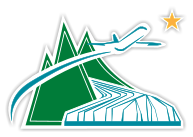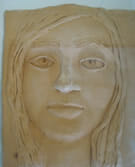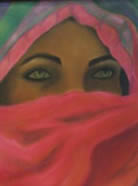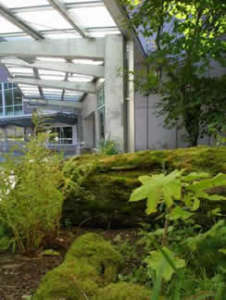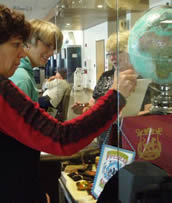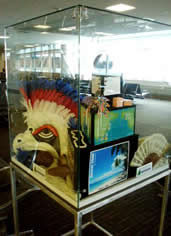Public Art & Music
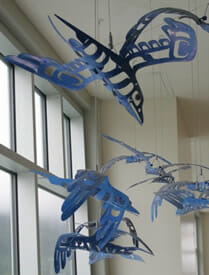 The Juneau International Airport has a long history as a public art venue. Currently, nearly one million visitors pass through the Airport terminal each year, making its role as a gateway critically important to the community, region, and state. Artwork adds beauty to the Airport, reflects the culture and character of the community and helps create an inviting atmosphere for the enjoyment of passengers, workers, and visitors. The Airport has recognized these values and embraced the arts, incorporating both visual and performing arts in the terminal. Current Airport art programs include:Music on the Fly; rotating exhibits in the glass display boxes; 1% art acquisitions from Capital Improvement Project (CIP) funds, temporary exhibits of loaned art; and special projects such as scout projects.
The Juneau International Airport has a long history as a public art venue. Currently, nearly one million visitors pass through the Airport terminal each year, making its role as a gateway critically important to the community, region, and state. Artwork adds beauty to the Airport, reflects the culture and character of the community and helps create an inviting atmosphere for the enjoyment of passengers, workers, and visitors. The Airport has recognized these values and embraced the arts, incorporating both visual and performing arts in the terminal. Current Airport art programs include:Music on the Fly; rotating exhibits in the glass display boxes; 1% art acquisitions from Capital Improvement Project (CIP) funds, temporary exhibits of loaned art; and special projects such as scout projects.
The terminal renovation projects that occurred between 2008 and 2012 created the need to review Airport art policies. Many of the exhibits were aged and in poor condition. An inventory of art in the terminal was completed in 2008 and a significant quantity of art was removed from the terminal to make way for construction. The newly constructed areas of the terminal provided opportunities for installing new works of art, and reconfiguring and updating existing art displays. However, environmental, space, and security constraints limit the amount and types or art that can be reasonably displayed in the terminal.
The Airport’s interest in a robust advertising program also affects the available areas to display art. The Airport has worked closely with its advertising firm, Lamar Transit, LLC, to encourage artist “place based” advertising that positively contributes to the ambiance of the terminal. Given the limited wall and display areas in the terminal, revenue from advertising must be balanced against art displays.
Juneau International Airport’s Public Art program hit a high note with the introduction of “Music on the Fly!” in 2013. The music program showcases local entertainers offering a variety of classical, jazz and contemporary music appropriate for all ages. The Juneau Arts & Humanities Council coordinates the scheduling of local musicians and advertises upcoming musical events. Performances occur throughout the year with weekly performances on Sunday evenings during the Airport’s busy summer months, June through September, and monthly or holiday-related performances during the remainder of the year. The music venue is in the east wing of the terminal building at the first floor window alcove across from the baggage belt.
Find the performance schedule of your favorite local musicians or sign up to perform at the Airport at http://jahc.org/music-fly.
Come enjoy the music at your Airport!
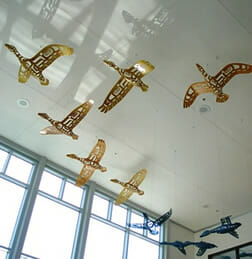 The City and Borough of Juneau Assembly has fostered the development of culture and the arts through the purchase or commissioning of works of art for municipal facilities. The local ordinance requires that at least one percent of appropriations for capital expenditures for facilities that receive significant public use be devoted to the acquisition of works of art to be displayed at those facilities. This policy is commonly referred to as the 1% for Art program.
The City and Borough of Juneau Assembly has fostered the development of culture and the arts through the purchase or commissioning of works of art for municipal facilities. The local ordinance requires that at least one percent of appropriations for capital expenditures for facilities that receive significant public use be devoted to the acquisition of works of art to be displayed at those facilities. This policy is commonly referred to as the 1% for Art program.
When a construction or renovation project meets the parameters that require investment in art through the 1% for Art program, an art selection panel is appointed to review and select works of art for inclusion in the project.
The Juneau International Airport, with nearly one million passengers passing through its terminal each year, is a major public facility in Juneau and has incorporated the 1% for Art into many of its large projects. Most recently, as part of the 2010 renovation and addition to the terminal’s east wing, the Airport used 1% for Art funds to commission artwork by Janice Criswell and Steve Henrikson. Their hanging sculpture, “Wetland Wings,” is located in the two story vestibule of the east wing, near baggage claim. Flocks of migrating birds constructed of metal and glass in the Tlingit “form line” art style greet arriving visitors en route to the baggage area. The sculpture celebrates the birds of the Mendenhall wetlands, the 4,000-acre refuge that surrounds the Airport. The birds represented in the sculpture are Arctic Terns, Bonaparte’s Gulls, Mallard Ducks, and Snow Geese.
Rotating Student Art Exhibits at the Airport
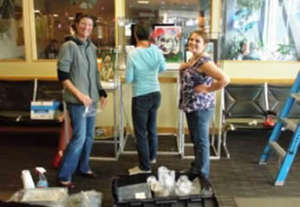
Heather Ridgeway, Nancy Lehnhart and Nicole Nelson install the first Fuel the Spark for Art exhbit in August 2013.
Juneau’s budding young artists have a venue for displaying their artwork at the Airport! An agreement between the Airport and the Juneau Arts & Humanities Council dedicates a set of three glass display boxes at the Airport for a long-term program focused on revolving student art exhibits.
The program known as “Fuel the Spark for Art,” is the culmination of months of hard work spearheaded by Thunder Mountain High School student, Nicole Nelson, who undertook the community service project in 2013 as part of her quest of Girl Scouts’ highest achievement, the Gold Award. Through energetic fundraising and creative vision, Nicole launched the “Fuel the Spark for Art” program to heighten public awareness and appreciation of the school art programs and provide young artists throughout the community an opportunity to experience the thrill of seeing their artwork on display, elegantly showcased in a busy public venue.
The student art display boxes are located on the second floor of the terminal’s east wing, at the top of the escalator. New exhibits are installed approximately every three to four months. Be sure to stop by the Airport to see the latest works by Juneau’s young artists. The creativity of the students’ artwork is evidence that the future of Juneau’s vibrant art community is a bright one!
Eagle Scout Project
The Airport has been the beneficiary of several scouting projects over the years, including the 2013 Rain Forest Garden project planned and implemented by Thunder Mountain High School senior, Morgan Nichols. Morgan completed the community service project in his quest to attain the Eagle Scout Award, the Boy Scouts’ highest achievement. A high school track and field star and an avid outdoor enthusiast, Morgan was active in scouting since first grade.
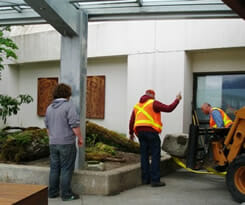
Morgan Nichols worked with Airport staff, Mark Lykins and Dana Ritter, who used heavy equipment to move large logs and boulders into place.
The Rain Forest Garden is a raised bed of plantings located on the north side of the terminal’s main entrance. Many of the plants are native species collected at various sites on the Airport property. Key features of the garden are the river rock swale that collects and directs the downspout’s rain water to support a marsh-like ecosystem in the center of the garden and a large, moss-covered, “nurse log” that nourishes a young spruce tree at the garden’s edge. During the summer months, Airport visitors can view some of the common wildflowers of the area upon their arrival at the Airport.
Morgan embarked on his college career in the Fall of 2014, studying engineering at the University of Idaho. As he continues to grow, so does the garden he began. The Rain Forest Garden plants are established and the natural-like landscape is adding beauty to the Airport entrance that has become a favorite photo backdrop for many visitors.
Come watch our garden grow!
In May 2013 the Airport entered into an agreement with Juneau’s Sister Cities Committee to install a series of rotating international-themed exhibits using one of the large glass display boxes inside the secure Departure Lounge. Each exhibit highlights one of Juneau’s sister city relationships and displays art and objects from, and informational materials about, the featured sister city.
Juneau currently enjoys international sister city status with the following cities:
- Chia-Yi City, Taiwan, China
- Whitehorse, Yukon Territory, Canada
- Vladivostok, Russia
- Mishan City, Heilonjiang Province, People’s Republic of China
Kalibo, Philippines, a city with nearly 75,000 residents, is slated to become Juneau’s newest sister city. Kalibo serves as a tourism gateway to Boracay Island, famous for its idyllic, white sandy beaches. Tourism is important to Kalibo’s economy, just as it is to Juneau’s.
Many members of the Juneau Filipino community have roots in Kalibo. Formalizing a sister city relationship with Kalibo will enhance strong, exiting ties between the communities. A number of exchanges between the cities have already occurred, including cultural exchanges, business trade, and the provision of humanitarian aid after recent natural disasters in Kalibo.
The Airport is pleased to provide a venue for the colorful, informative displays prepared by the Sisters Cities Committee. The exhibits serve as a reminder of our inter-connectedness with other cultures around the world and are enjoyed by the many passengers who transit through our community’s airport.
